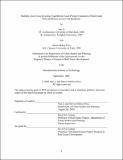Multiple asset class investing : equilibrium asset pricing evaluation of real estate risk and return across four quadrants
Author(s)
Li, Nan, 1972-; Price, Steven McKay
DownloadFull printable version (330.3Kb)
Alternative title
Equilibrium asset pricing evaluation of real estate risk and return across four quadrants
Other Contributors
Massachusetts Institute of Technology. Dept. of Urban Studies and Planning.
Advisor
David M. Geltner.
Terms of use
Metadata
Show full item recordAbstract
The major objective of this study is to test equilibrium asset pricing models with respect to how well they price risk across multiple asset classes; including the four quadrants of real estate. While using the Geltner (1999) paper as a springboard for our approach, this thesis both updates Professor Geltner's earlier work and extends its scope through the testing of additional models and asset classes. Using historical data to derive beta estimates, we empirically test several variations of the Capital Asset Pricing Model (CAPM). These variations include the traditional, single-beta, Sharpe-Lintner CAPM, as well as the multi-beta, Fama-French CAPM. For the single-factor formula we explore the use of two different market portfolio proxies, the S&P 500 Index and the National Wealth Portfolio (NWP). We also apply the single-factor formula to a non-wealth based, consumption oriented approach. Test results show the NWP based CAPM to be the strongest model, being both robust and statistically significant in its pricing of asset volatility. When using the traditional S&P 500 index as the market proxy, the basic CAPM performs surprisingly well, though not as well as the NWP version. The multi-beta Fama-French model explains a large amount of price variation, however, only the market and size factors prove to be statistically significant at the 95% confidence level. (cont.) In a dramatic departure from what was found roughly fifteen years ago, the consumption model's performance was lackluster; supporting a widespread belief that there may be empirical issues with the measurement of quarterly consumption. The most interesting finding across all models tested was the behavior of the housing asset class. Housing appears to be an outlier that doesn't seem to fit in with the rest of the asset classes using linear pricing models. All the models display a statistically significant intercept, suggesting that there is a component of risk, perhaps a significant component (as perceived by investors relative to treasury bills), that is not captured in any of these risk models.
Description
Thesis (S.M.)--Massachusetts Institute of Technology, Dept. of Urban Studies and Planning, 2005. This electronic version was submitted by the student author. The certified thesis is available in the Institute Archives and Special Collections. Includes bibliographical references (leaves 38-40).
Date issued
2005Department
Massachusetts Institute of Technology. Department of Urban Studies and PlanningPublisher
Massachusetts Institute of Technology
Keywords
Urban Studies and Planning.